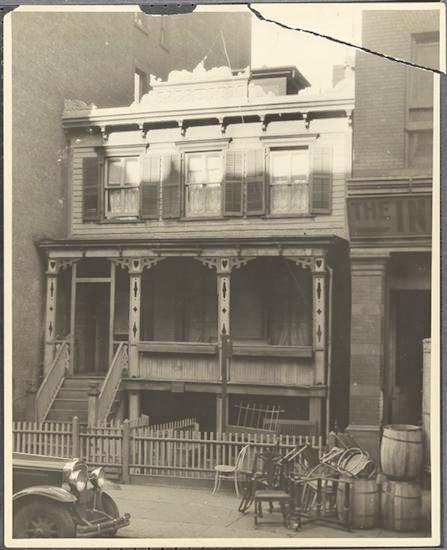Back in May, Ephemeral New York published a post about Manhattan's most charming holdout buildings—the small 19th century walkups that managed to evade the wrecking ball and remain part of the contemporary cityscape.
In the comments section, a reader sent in a link to a photo of another holdout I'd never seen before. It's a little relic of mid-19th century New York, a clapboard two-story dwelling with a rustic porch, wood shutters, and picket fence with a gate at 109 West 124th Street in Harlem (above, in 1932).
It doesn't exist anymore; the storybook-like house between Lenox Avenue and Adam Clayton Powell Boulevard disappeared in the mid-20th century (below, 1939-1941).
Exactly when it met its end is a mystery, as is how the house successfully hung on for so long. For the century or so that it existed, Harlem went from a bucolic village to a middle class suburb and by the 1920s was the center of Black New York—a magnet for people seeking better opportunities and an incubator of music, art, writing, and culture.
Luckily, some information about the people who lived there gives us something of a narrative. Though it's unclear when it was built (I'm estimating the 1850s, as it resembles these East Side 1850s houses), by 1876 it was occupied by a Theodore van Houten, according to a New York City directory. "Agent" was listed after van Houten's name, a clue to his occupation.
In 1887, the Real Estate Record and Building Guide wrote that an Eliza van Houten—likely Theodore's widow by that time—sold number 109 to a Charles Rilling. The selling price? $10,000. (Above, in an undated photo.)
After the turn of the century, a man named Stanley Lewinsky Corwin resided at the home. Corwin is listed as a delegate to the Second New York City Conference of Charities and Correction in 1911. Perhaps he was a solidly middle class civil servant.
Interestingly, the house spent some time as an art school called the Lenox Art Academy. Several newspaper references in the early 1900s note the classes the school offered and gallery exhibitions.
The trail for number 109 gets cold after that. A tax photo of the house was taken by the city between 1939-1941—the last dated reference I found. It's a shame this little piece of pre-Civil War Harlem, slipped away from the cityscape. What a story about Harlem's evolution (above, Lenox Avenue and 124th Street) it could tell!
[Top photo: MCNY 33.173.458; second photo: NYC Department of Records and Information Services; third photo: NYPL; fourth photo: New-York Historical Society]




No comments:
Post a Comment
Note: Only a member of this blog may post a comment.